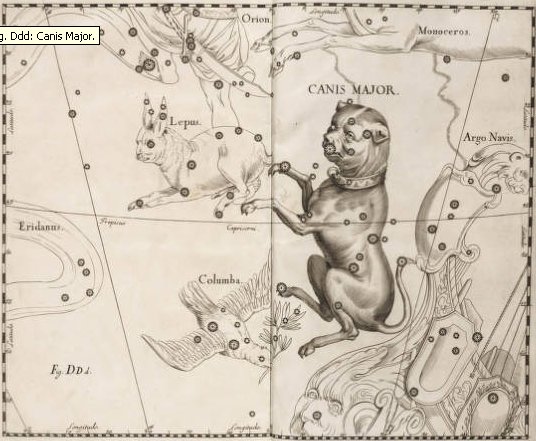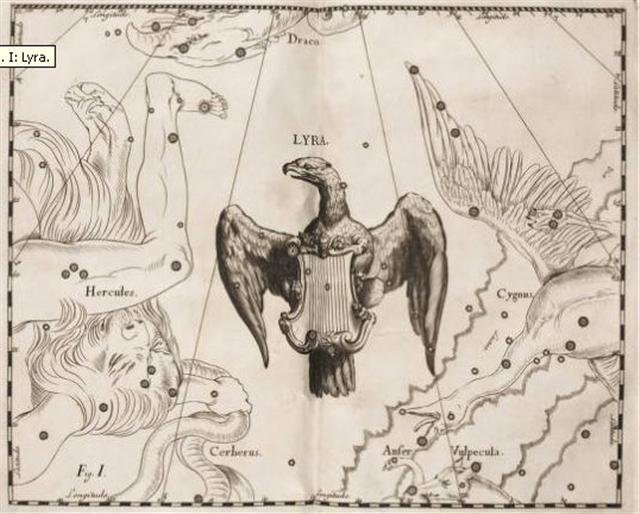Ga2-27
should
mark
a
'zero
day'
because
22 /
7
was
the
conventional approximation
for
π.
Indeed
MAY
17
was
day
364
-
227
=
137:
 |
 |
 |
 |
| Ga2-27 |
Ga2-28 |
Ga2-29 |
Ga3-1 (60) |
| MAY 17 (364 - 227 = 137) |
18 (228 - 90 = 138) |
19 |
20 |
| 8h (121.7) |
ρ Puppis (122.0), Heap of Fuel (122.1), ζ Monocerotis (122.3), ψ Cancri (122.6), Regor (122.7) |
Tegmine (123.3) |
Al Tarf (124.3) Ras Algethi
|
| χ Gemini (121.0), Naos (121.3) |
| July 20 (201) |
21 (*122) |
7-22 |
23 |
| ºJuly 16 (181 + 16) |
17 (*118) |
18 |
19 (200) |
| 'June 23 |
ST JOHN'S EVE |
25 (*96) |
26 (177) |
| "June 9 (*80) |
10 |
11 |
12 (163) |
| NAKSHATRA DATES: |
| NOVEMBER 16 (320) |
17 |
18 (*242) |
19 |
| 20h (304.4) |
Shang Wei (305.2), θ Sagittae (305.4), Tseen Foo (305.6), ξ Capricorni (305.8) |
Tso Ke (306.3) |
Gredi (307.2), σ Capricorni (307.5), Alshat (307.9) |
| η Sagittae (304.2), δ Pavonis (304.4) |
| January 19 (384) |
20 |
21 |
22 |
| ºJanuary 15 (*300) |
16 |
17 |
1-18 (383) |
| 'December 23 |
CHRISTMAS EVE |
25 (*279) |
26 (360) |
| 'December 9 |
10 |
11 (*265) |
12 (346) |
Thus day 137 was definitely connected with π. And Rei in Ga2-27 is the 2nd such glyph in the text. The first Rei - a tiny fresh and new one - was 27 days earlier at Ga1-30:
 |
 |
 |
 |
 |
| Ga1-30 |
Ga2-1 |
Ga2-2 |
Ga2-3 (33) |
Ga2-4 |
| APRIL 20 (110) |
21 (*31) |
22 |
23 |
24 (*399) |
| Furud (94.9) |
Well-22 / Arkū-sha-pu-u-mash-mashu-9 |
no star listed (96) |
β Monocerotis, ν Gemini (97.0) |
no star listed (98) |
| δ Columbae (95.2), TEJAT POSTERIOR, Mirzam (95.4), CANOPUS (95.6), ε Monocerotis (95.7), ψ1 Aurigae (95.9) |
| June 23 |
ST JOHN'S EVE |
25 |
26 (6 * 29½ = 177) |
27 |
| ºJune 19 |
20 (*91) |
SOLSTICE |
22 |
23 |
| 'May 27 (7 * 21 = 147) |
28 (*68) |
29 |
30 |
31 |
| "May 13 (7 * 19 =133) |
14 |
15 (*55) |
16 (136) |
17 |
| NAKSHATRA DATES: |
| OCTOBER 20 |
21 (*214) |
22 (295) |
23 |
24 |
| Purva Ashadha-20 |
Kaus Borealis (279.3) |
ν Pavonis (280.4), κ Cor. Austr. (280.9) |
Abhijit-22 |
| KAUS MEDIUS, κ Lyrae (277.5), Tung Hae (277.7) |
φ Oct. (278.1), KAUS AUSTRALIS (278.3), ξ Pavonis (278.4), Al Athfar (278.6) |
θ Cor. Austr. (281.0), VEGA (281.8) |
| December 23 |
CHRISTMAS EVE |
25 |
26 (360) |
27 |
| ºDec 19 (*273) |
20 |
SOLSTICE |
22 |
23 (357) |
| 'November 26 |
27 |
28 |
29 (333) |
30 (*254) |
| "November 12 (*236) |
13 |
14 |
15 |
16 (320) |
Furud at Ga1-30 is ζ at the right up-right back paw of Canis Major touching the left wing of the Dove, above her 'stolen' (ra'u, Dogon: Gouyo!) green twig of leaves (rau):
| Rau Rau 1. (Also: raupá) leaf of a plant, stem and leaves. 2. Hundred: e tahi te rau, e rua te rau, etc., 100, 200... Also seems to have been used in the meaning of 'many'. Tu'u henua rau, someone who has travelled to many countries (such were called in the 19th century natives who had travelled abroad, employed as sailors). Compare with: tai raurau-á riki. Vanaga.
Rau hei. 1. Branch of mimosa. 2. Killed enemy. 3. Hanged 'fish'. 'Branche du mimosa (signe de mort), ennemie túe (poisson suspendu)' according to Jaussen. Barthel.
Ra'u 1. To take something without the owner's permission; to seize something forcibly. 2. Ra'u maahu, ancient expression, literally: to appropriate the steam (maahu) of the food just taken out of an earth oven. It refers to intruders coming to help themselves uninvited. Warriors off to a battle used to be told: E ra'u maahu no koe, o pagaha'a! meaning: 'Eat little, lest you be heavy (and lose your agility).' Vanaga.
1. Sa.: la'u, to clear off, to carry away; la'u mai, to bring. Uvea: laku, to send, to throw into. Ha.: laulau, a bundle, a bag; a wrapper of a bundle, the netting in which food is carried; lalau, to seize, to catch hold of. 2. To.: lau, lalau, lauji, to pinch with the fingers, to nip. Ha.: lau, to feel after a thing; lalau, to extend (as the hand), to seize, to catch hold of. 3. Sa.: lau, a leaf; lalau, to be in leaf; laulau, a food tray plaited from a coconut leaf, to set out food on such a tray or on a table. To.: lau, lou, a leaf; laulau, a tray. Fu., Uvea, Nuguria: lau, a leaf. Niuē: lau, a leaf; laulau, a table. Ha.: lau, a leaf; laulau, the netting in which food is carried. Ma., Ta., Rarotonga, Rapanui, Paumotu, Nukuoro, Fotuna: rau, a leaf. Mgv.: rau, rou, id. Mq.: au, ou, id. Churchill 2.
Ta.: rauhuru, dry banana leaf. Mq.: auhuu, id. (To.: hulu, leaves dry and dead.) Ha.: lauhulu, banana leaf. Churchill. |

Naos (the Ship) at Ga2-27 is ζ Puppis in the right upper corner of the star-board shield in the stern of Argo Navis and close to the first of the ropes leading up to the top of her mast.
From Roman times to the time of rongorongo there were 27 precessional days. Therefore heliacal Furud (ζ Canis Majoris) in June 23 corresponded to heliacal Naos (ζ Puppis) in 'June 23.
| Manacle |
ziqq |
Phoenician zayin |
 |
Greek zeta |
Ζ (ζ) |
|
... Zeta (uppercase Ζ, lowercase ζ; Greek: ζήτα ... is the sixth letter of the Greek alphabet. In the system of Greek numerals, it has a value of 7. It was derived from the Phoenician letter Zayin. Letters that arose from zeta include the Roman Z and Cyrillic З ...
Zayin (also spelled Zain or Zayn or simply Zay) is the seventh letter of many Semitic abjads ... It represents the sound [z]. The Phoenician letter appears to be named after a sword or other weapon. (In Biblical Hebrew, 'Zayin' means sword, and the verb 'Lezayen' means to arm. In modern Hebrew, 'zayin' means penis and 'lezayen' is a vulgar term which generally means to perform sexual intercourse and is used in a similar fashion to the English word fuck, although the older meaning survives in 'maavak mezuyan' (armed struggle) and 'beton mezuyan' (armed, i.e., reinforced concrete). The Proto-Sinaitic glyph according to Brian Colless may have been called ziqq, based on a hieroglyph depicting a 'manacle'. |
Adara (Ga2-10) is ε Canis Majoris at the belly of the dog and the name means 'the Virgins':
 |
 |
 |
 |
| Ga2-9 |
Ga2-10 (40) |
Ga2-11 |
Ga2-12 |
| APRIL 29 (*39) |
30 |
MAY 1 (121) |
2 (*407) |
| Mash-mashu-sha-Risū-10 |
Adara (104.8) |
ω Gemini (105.4), Alzirr (105.7), Muliphein (105.8), Mekbuda (105.9) |
7h (106.5) |
| θ Gemini (103.0), ψ8 Aurigae (103.2), Alhena (103.8), ψ9 Aurigae (103.9) |
no star listed (106) |
| July 2 |
3 |
4 (181 + 4) |
5 |
| ºJune 28 |
29 (*100) |
30 |
ºJuly 1 (182) |
| 'June 5 |
6 |
7 (*78) |
8 |
| "May 22 |
23 |
24 (144) |
25 (*65) |
| NAKSHATRA DATES: |
| OCTOBER 29 (*222) |
30 |
31 |
NOVEMBER 1 (305) |
| χ Oct. (286.0), Ain al Rami (286.2), δ Lyrae (286.3), κ Pavonis (286.5), Alya (286.6) |
ξ Sagittarii (287.1), ω Pavonis (287.3), ε Aquilae, ε Cor. Austr., Sulaphat (287.4), λ Lyrae (287.7), Ascella, Bered (Ant.) (287.9) |
Al Na'ām-18 / Uttara Ashadha-21 |
19h (289.2) |
| NUNKI (288.4), ζ Cor. Austr. (288.5), Manubrium (288.8), ζ Aquilae (288.9) |
λ Aquilae (Ant.) (289.1), γ Cor. Austr (289.3), τ Sagittarii (289.4), ι Lyrae (289.5), δ Cor. Austr. (289.8) |
| January 1 (366) |
2 |
3 |
4 |
| ºDecember 28 |
29 |
30 (364) |
31 (*285) |
| 'December 5 |
6 |
7 |
8 (342) |
| "November 21 (325) |
22 |
23 |
24 (*248) |
Canis Major could like the Sun have had two wives, one in Columba and one in Argo Navis - one triumphantly descending from above with spread out wings and greenery (or Granary) as proof of summer and the other stranded on 'Land'.
... Hamiora Pio once spoke as follows to the writer: 'Friend! Let me tell of the offspring of Tangaroa-akiukiu, whose two daughters were Hine-raumati (the Summer Maid - personified form of summer) and Hine-takurua (the Winter Maid - personification of winter), both of whom where taken to wife by the sun ... Now, these women had different homes. Hine-takurua lived with her elder Tangaroa (a sea being - origin and personified form of fish). Her labours were connected with Tangaroa - that is, with fish. Hine-raumati dwelt on land, where she cultivated food products, and attended to the taking of game and forest products, all such things connected with Tane ...
If the Sea began when Nunki was with the Sun and ended when Nunki was at the Full Moon, then it should have meant the domain of Tagaroa (personifying the Sea) also ended at the latter time and that the rule of Tane (personifying Land) took hold at Ga2-11.
From Ga2-11 to Ga2-27 there were 16 days and ω Gemini (105.4) should therefore reappear to view when Naos (121.3) rose with the Sun.


Castor holds a Lyre in his right hand, at ω, and this could be a Sign pointing at the back side of his life - alluding to Vega high up as the place where he was destined to go after his death:

... In ancient Mexico they used to strike a hard physical blow to the body of the victim, and then the soul of the victim was believed to ascend directly to the heavens, sidestepping the perils of the underworld ...
|









